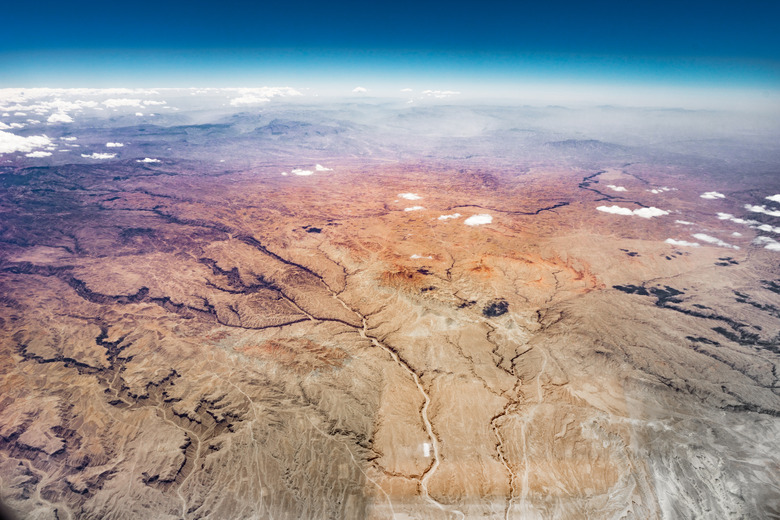What Four Elements Make Up Almost 90% Of The Earth?
If asked to list the chemical elements that make up most of the Earth, you might be surprised by how hard it is to guess the right elements without knowing more than the average person does about all of that dirt, rock and metal underfoot. (You would also want to know if your quizzer was inquiring about the composition of the atmosphere above the Earth, also a common geoscience topic.)
Elements are different kinds of atoms, and as of 2020, 118 of them had been identified, 92 of which occur in significant amounts in nature. While it's impossible to know for certain the precise composition of the deeper layers of Earth, four elements alone make up almost 90 percent of the Earth's uppermost portion, or crust; four more account for nine-tenths of the remainder.
Layers of the Earth
Layers of the Earth
The more-or-less-spherical Earth, about 8,000 miles (just under 13,000 kilometers, or km) through the middle, is divided into three geologic layers:
- A very thin crust extending down from the surface, about 3 miles (5 km) thick;
- a mantle about 1,800 miles
(2,890 km) thick, composed mainly of magnesium and iron rocks;
- a core about 2,200 miles (3,400 km) thick and including a solid iron center surrounding a molten (hot liquid) "ring" of iron and nickel (see below).
Earth's crust is made up almost entirely of eight elements, four of them alone claiming almost nine-tenths of this layer's total weight: oxygen comes in at 46.6 percent by mass, followed by silicon at 27.7 percent, aluminum at 8.1 percent and iron at 5 percent.
- The remaining crust elements are calcium, 3.6 percent; sodium, 2.8 percent, potassium, 2.6 percent, and magnesium, 2.1 percent.
Nearly 100 percent of the mass of Earth's core is composed of the two elements iron and nickel. Scientists have concluded this from the knowledge that the core must be 13 times as dense as water, leaving only some combination of molten iron and nickel as plausible candidates.
The Most Abundant Elements on Earth
The Most Abundant Elements on Earth
Oxygen: This familiar element, is number 6 on the periodic table of elements, makes up about 47 percent of the mass of the crust, and is also abundant (fortunately) in the atmosphere. It is also the main component, by mass, of water.
Since oxygen atoms are light compared to the other predominant elements in Earth's crust, the fact that their total mass accounts for almost half of the crust means that the fraction of its atoms that consists of oxygen is even higher than the mass fraction.
Silicon: This element, number 14 on the periodic table, exists as a crystal solid. It reacts poorly with most other elements, but eluded isolation by chemists for a long time owing to its affinity for oxygen and thus its tendency to remain "disguised" as silicon oxide.
- Silicon is not to be confused with silicone, which is a polymer made of silicon, oxygen and other elements. It is commonly used in oil, grease and other physical media.
Aluminum: This metal is number 13 on the periodic table, one atomic number and thus one proton shy of silicon. It is non-magnetic and highly reactive, so much so that pure aluminum is rarely found. Instead, it is usually found embedded within rocks and combined with other compounds
Iron: Iron, atomic number 26, is a famous element, vital in both construction and engineering (iron accounts for almost all of the mass of most kinds of steel, for instance) and human physiology (iron is a required component of the oxygen-binding red blood cells, or erythrocytes, in your bloodstream). Is is found in all three of Earth's layers in significant amounts.
Cite This Article
MLA
Beck, Kevin. "What Four Elements Make Up Almost 90% Of The Earth?" sciencing.com, https://www.sciencing.com/four-elements-make-up-almost-90-earth-2592/. 16 February 2020.
APA
Beck, Kevin. (2020, February 16). What Four Elements Make Up Almost 90% Of The Earth?. sciencing.com. Retrieved from https://www.sciencing.com/four-elements-make-up-almost-90-earth-2592/
Chicago
Beck, Kevin. What Four Elements Make Up Almost 90% Of The Earth? last modified March 24, 2022. https://www.sciencing.com/four-elements-make-up-almost-90-earth-2592/
